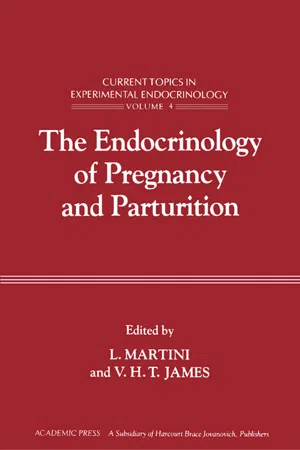
The Endocrinology of Pregnancy and Parturition
Current Topics in Experimental Endocrinology, Vol. 4
- 304 pages
- English
- ePUB (mobile friendly)
- Available on iOS & Android
The Endocrinology of Pregnancy and Parturition
Current Topics in Experimental Endocrinology, Vol. 4
About This Book
Current Topics in Experimental Endocrinology, Volume 4: The Endocrinology of Pregnancy and Parturition deals with the various aspects of pregnancy and parturition. The book discusses pregnancy and parturition in marsupials; the vital role of the corpus luteum; and the endocrinology of the preimplantation period, looking into the variety of hormones and other agents and their involvement in the implantation process. The text also describes the critical role of prolactin in pregnancy; the role of human chorionic gonadotropin in early pregnancy; and specific pregnancy proteins. The clinical use of human placental lactogen in pregnancy; estrogen and progestrone production in human pregnancy; and the role of oxytocin in parturition; threatened abortion are also considered. Endocrinologists, obstetricians, gynecologists, reproductive physiologists, and students taking related courses will find the book invaluable.
Frequently asked questions
Information
Specific Pregnancy Proteins
Publisher Summary
I Introduction
II Schwangerschaftsprotein 1 (SP1)
A Historical Note
Table of contents
- Cover image
- Title page
- Table of Contents
- Contributors
- Editorial Board
- Copyright page
- Contributors
- Preface
- Pregnancy and Parturition in Marsupials
- The Endocrinology of the Preimplantation Period
- Prolactin and Pregnancy
- Human Chorionic Gonadotropin in Early Pregnancy
- Specific Pregnancy Proteins
- Human Placental Lactogen
- Estrogen and Progestrone Production in Human Pregnancy
- The Role of Oxytocin in Parturition
- Threatened Abortion
- Index